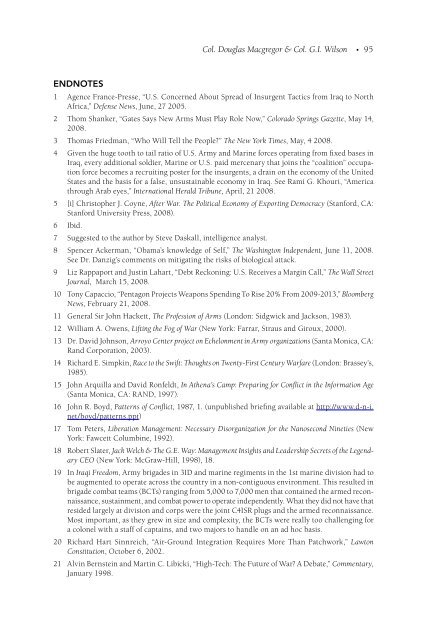Americas Defense Meltdown - IT Acquisition Advisory Council
Americas Defense Meltdown - IT Acquisition Advisory Council
Americas Defense Meltdown - IT Acquisition Advisory Council
Create successful ePaper yourself
Turn your PDF publications into a flip-book with our unique Google optimized e-Paper software.
Col. Douglas Macgregor & Col. G.I. Wilson • 95Endnotes1 Agence France-Presse, “U.S. Concerned About Spread of Insurgent Tactics from Iraq to NorthAfrica,” <strong>Defense</strong> News, June, 27 2005.2 Thom Shanker, “Gates Says New Arms Must Play Role Now,” Colorado Springs Gazette, May 14,2008.3 Thomas Friedman, “Who Will Tell the People?” The New York Times, May, 4 2008.4 Given the huge tooth to tail ratio of U.S. Army and Marine forces operating from fixed bases inIraq, every additional soldier, Marine or U.S. paid mercenary that joins the “coalition” occupationforce becomes a recruiting poster for the insurgents, a drain on the economy of the UnitedStates and the basis for a false, unsustainable economy in Iraq. See Rami G. Khouri, “Americathrough Arab eyes,” International Herald Tribune, April, 21 2008.5 [i] Christopher J. Coyne, After War. The Political Economy of Exporting Democracy (Stanford, CA:Stanford University Press, 2008).6 Ibid.7 Suggested to the author by Steve Daskall, intelligence analyst.8 Spencer Ackerman, “Obama’s knowledge of Self,” The Washington Independent, June 11, 2008.See Dr. Danzig’s comments on mitigating the risks of biological attack.9 Liz Rappaport and Justin Lahart, “Debt Reckoning: U.S. Receives a Margin Call,” The Wall StreetJournal, March 15, 2008.10 Tony Capaccio, “Pentagon Projects Weapons Spending To Rise 20% From 2009-2013,” BloombergNews, February 21, 2008.11 General Sir John Hackett, The Profession of Arms (London: Sidgwick and Jackson, 1983).12 William A. Owens, Lifting the Fog of War (New York: Farrar, Straus and Giroux, 2000).13 Dr. David Johnson, Arroyo Center project on Echelonment in Army organizations (Santa Monica, CA:Rand Corporation, 2003).14 Richard E. Simpkin, Race to the Swift: Thoughts on Twenty-First Century Warfare (London: Brassey’s,1985).15 John Arquilla and David Ronfeldt, In Athena’s Camp: Preparing for Conflict in the Information Age(Santa Monica, CA: RAND, 1997).16 John R. Boyd, Patterns of Conflict, 1987, 1. (unpublished briefing available at http://www.d-n-i.net/boyd/patterns.ppt)17 Tom Peters, Liberation Management: Necessary Disorganization for the Nanosecond Nineties (NewYork: Fawcett Columbine, 1992).18 Robert Slater, Jack Welch & The G.E. Way: Management Insights and Leadership Secrets of the LegendaryCEO (New York: McGraw-Hill, 1998), 18.19 In Iraqi Freedom, Army brigades in 3ID and marine regiments in the 1st marine division had tobe augmented to operate across the country in a non-contiguous environment. This resulted inbrigade combat teams (BCTs) ranging from 5,000 to 7,000 men that contained the armed reconnaissance,sustainment, and combat power to operate independently. What they did not have thatresided largely at division and corps were the joint C4ISR plugs and the armed reconnaissance.Most important, as they grew in size and complexity, the BCTs were really too challenging fora colonel with a staff of captains, and two majors to handle on an ad hoc basis.20 Richard Hart Sinnreich, “Air-Ground Integration Requires More Than Patchwork,” LawtonConstitution, October 6, 2002.21 Alvin Bernstein and Martin C. Libicki, “High-Tech: The Future of War? A Debate,” Commentary,January 1998.


